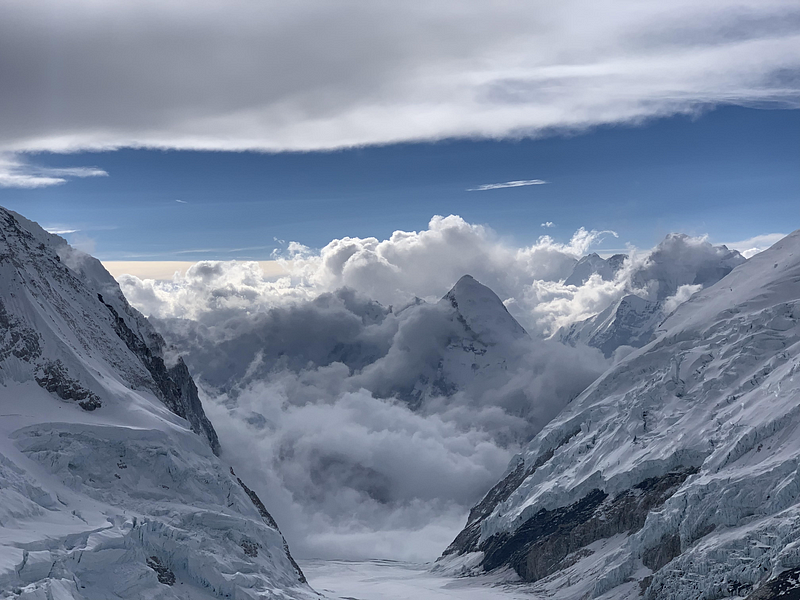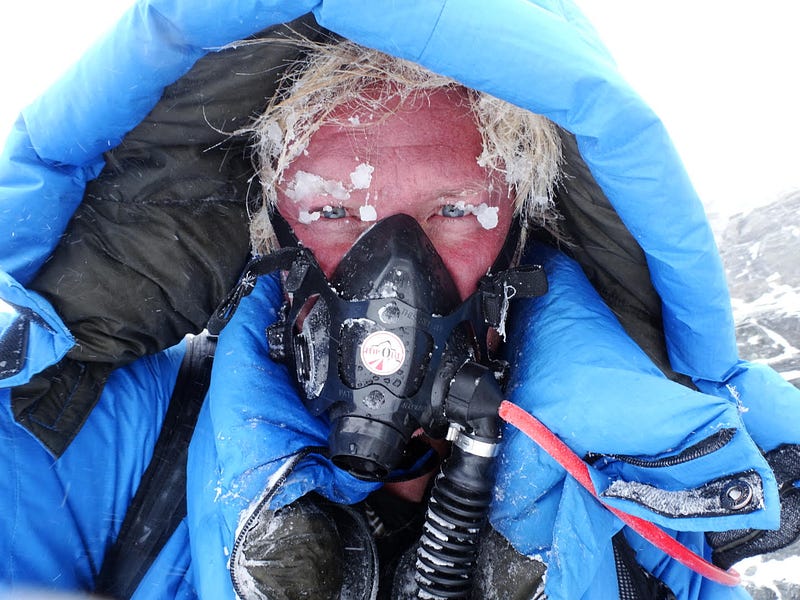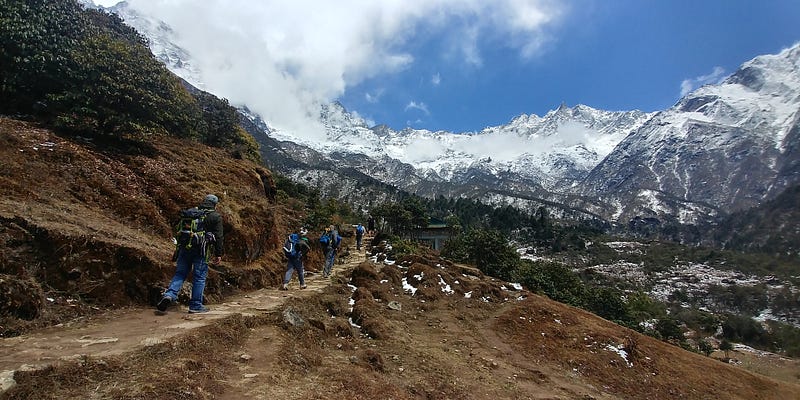Science at the Top of the World
A team of international scientists study climate change on Mount Everest
*Content Warning: This story contains visual content that some readers may find disturbing
By Stella Harvey

The view from the top
On an early morning in May 2019, John All stood at the top of the world. Looking down from the peak of the Himalaya Mountains in Nepal, he watched the sun rise from a vantage point only a lucky few will ever see.
“I felt like I was on the space station because [as] you’re looking down, you can see the curvature of the Earth,” John said. “As the sun was rising, I could see the sun, and then I could see the darkness on other parts of the horizon.”
John, a geoscientist and research professor in Western’s environmental science program, has returned to the Himalayas year after year to study the effects climate change has on the highest peaks on Earth.
Last spring, John returned to the region for the first time since 2014. During his last trip, John suffered a life-threatening accident.
After a massive avalanche killed 16 people, including a friend and member of John’s team, his group was stuck with a difficult decision: to forfeit their research opportunity, or continue to work in the area.

With the summit closed, John sent his remaining team members down the mountain and set up camp on his own to collect what samples he could before descending. As he began to explore the area, the glacier underneath him gave way — plummeting John 70 feet into a crevasse, a deep open crack in a glacier.
As he descended the deep fissure, John hit an ice shelf, breaking his fall along with 15 bones, including six vertebrae and his left arm. Banged up and bloody from the seven-story fall, John turned on his camera, explained what had happened, and began filming his attempt to climb out of the icy grave.
John worked for many grueling hours, periodically checking in to update his video diary. Finally, he was able to pull himself out of the slice of earth and called for help, barely making it to his tent before sun-down. After sending a message from his satellite phone, he was rescued by helicopter and transferred to Norvic International Hospital.
[embed]https://www.youtube.com/watch?v=l-LmuBc8lWc[/embed]
As he recovered, John reflected on the accident and why he survived. Over his many years of conducting research in remote areas, John took every mountain safety course he could and worked with search-and-rescue teams. He said these experiences are what allowed him to survive the unsurvivable. But what about the next generation of scientists?
“[It] was kind of a wake-up call,” John said. “I saw a lot of students in geology, biology and other dangerous fields going out and conducting field research without all that training that I had, and if they fell [into] a crevasse they wouldn’t survive.”
So, John packed his bags and came to Western to design the Mountain Environment Research Institute, a certificate program open to all majors at Western. He said the goal of the institute was to teach students safe research techniques and practices they could use in their endeavors.
[embed]https://www.youtube.com/watch?v=Od39JRykzZQ[/embed]
In October 2019, the Mountain Environment Research Institute was suspended due to a lack of funding. As a result, the faculty of the Department of Environmental Sciences voted to place Mountain Research Skills Certificate into moratorium, since two of the core classes will no longer be offered.
In the five years that he has been developing the Mountain Environment Research Institute, John said he’s gotten emails from students across the country asking how they could be a part of the institute.
“I know how to train people to continue conducting this research, but at some point, I’m not going to be able to do it anymore,” John said. “As a society, we desperately need to know what’s happening in the face of climate change, and the only way we’re going to find that out is by getting out there.”
The Journey
Three months before he took in the view from Lhoste in May 2019, Mount Everest’s neighboring peak, John arrived in Nepal to meet up with a team of international scientists. While the team was recruited through the American Climber Science Program — a nonprofit that conducts research in remote environments, members hailed from all over the world, with varying interests regarding climate change.
“Whenever I do an expedition like this, one of the keys is to involve as many different people in as many different expertise as possible,” John said.
Three of the team members were from Western; Eric DeChaine, professor of biology and herbarium curator at Western; Morgan Scott, an environmental studies graduate student; and John.
In March, the group embarked on a three-month expedition through the grassy valleys of Nepal before taking on the daunting task of summiting Mount Everest and Lhoste. In the weeks before the summit, the team planned to collect samples of vegetation and interview the Sherpa people about the impact global climate change, ecotourism, and the recent Nepali civil war has had on their homes.
John said usually, scientists and recreational climbers arrive at the base camp of Mount Everest in April in preparation for the summit.
But John and his team did something different.
Instead of heading straight for the mountains, the team arrived in the nearby valleys in March to begin their research. At an altitude of 13,000 feet, the group began their journey in the rocky fields of the Hinku valley, about 40 miles from Everest.

Slowly building up their tolerance to the increasingly thin air, each scientist worked on their research as they trekked, glacier-covered mountains surrounding them. Picking up and moving to the next site each day, the group slowly made their way to Mera Peak, 40 miles South of Mount Everest.
Eric worked on collecting data on vegetation to compare to past expeditions and published studies. Morgan conducted interviews about climate change and ecotourism with the help of Benup Adhikari and Mahendra Gahatraj, two graduate students from Tribhuvan University in Kathmandu, Nepal.
As they made their way to the Mera Peak high camp, the team passed through 16 villages. In each spot, Morgan, Benup and Mahdenra would meet in the morning to plan interviews. At the end of the day, they reviewed their notes and discussed their findings together.
Morgan said out of 60 interviews, most people talked about their desire for more tourism in the area. Morgan’s study also looked at the management of the World Heritage sites the Himalayas are a part of. Most people didn’t talk about park management, and instead discussed their livelihood, he said.
After making their way up the 21,000 foot Mera Peak, the team retreated back down to Lukla, a small town in north-eastern Nepal, before beginning their journey to Mount Everest’s base camp. The 40-mile trek wound the group through the lush, green fields of Phakding, around the opaque blue waters of the Gokyo Lakes and the snowy fields of Cho La Pass.

After days of working their way higher into the mountains, the team reached the 17,598 feet altitude of base camp, orange and yellow tents sprawled across the rocky grey terrain.
With much of their research already completed, the group prepared for the last leg of their expeditions: collecting snow samples all the way to the summit on Everest and Lhoste to analyze for black carbon and dust particulates.
After they acclimatized and collected samples at base camp, the group planned on splitting up: Johns group would summit Lhotse, while Morgan’s would attempt Everest.
In the weeks leading up to their attempt to the summit, Morgan caught a cough, which developed into a respiratory infection.
“At that altitude,” Morgan said, “you don’t have the same amount of oxygen in your body, so it doesn’t recuperate that fast for anything.”
He had recovered enough to make the trek to base camp, but Morgan was sleep-deprived and drained, unable to get back to 100% before it was time to make the dangerous trek up the highest mountain in the world.
“If you get a paper cut, which would normally heal overnight, like it will take a week [to heal], and it’ll still be fairly open. ”
Morgan decided to turn back, saving the 29,000 feet summit for another time.
John and his team continued to push toward the summit of Lhoste to collect samples. Safely making it to the nearly 28,000 foot peak, John and his team took in the view as they collected their final samples.
“Words can’t describe it. I mean it’s overwhelming,” John said. “It makes you appreciate how tiny you are, but also how lucky we are to see that on the world scale.”
Where do we go now?
After returning safely, the team started working through their data.
Morgan is currently processing the interview data he, Benup and Mahendra collected. Over the next year, he will finish his graduate thesis using the data and his notes. After he graduates, Morgan hopes to work on sending his findings to the park management of the world heritage sites they visited, to help inform their future practices and park-planning.
Eric DeChain is currently on sabbatical, but he will also process the data and samples he collected and compare it to previous data. The snow samples will be analyzed and compared to data collected on John’s previous expeditions.
John said now that the Mountain Environment Research Institute is no longer active, he is planning his next move. He said he will continue to work on the American Climber Science Program, pushing the limits of conducting research in the most remote places on earth.
“The reason we live is to make the world a better place, and I have this unique skill set,” John said. “That’s what drives me.”

